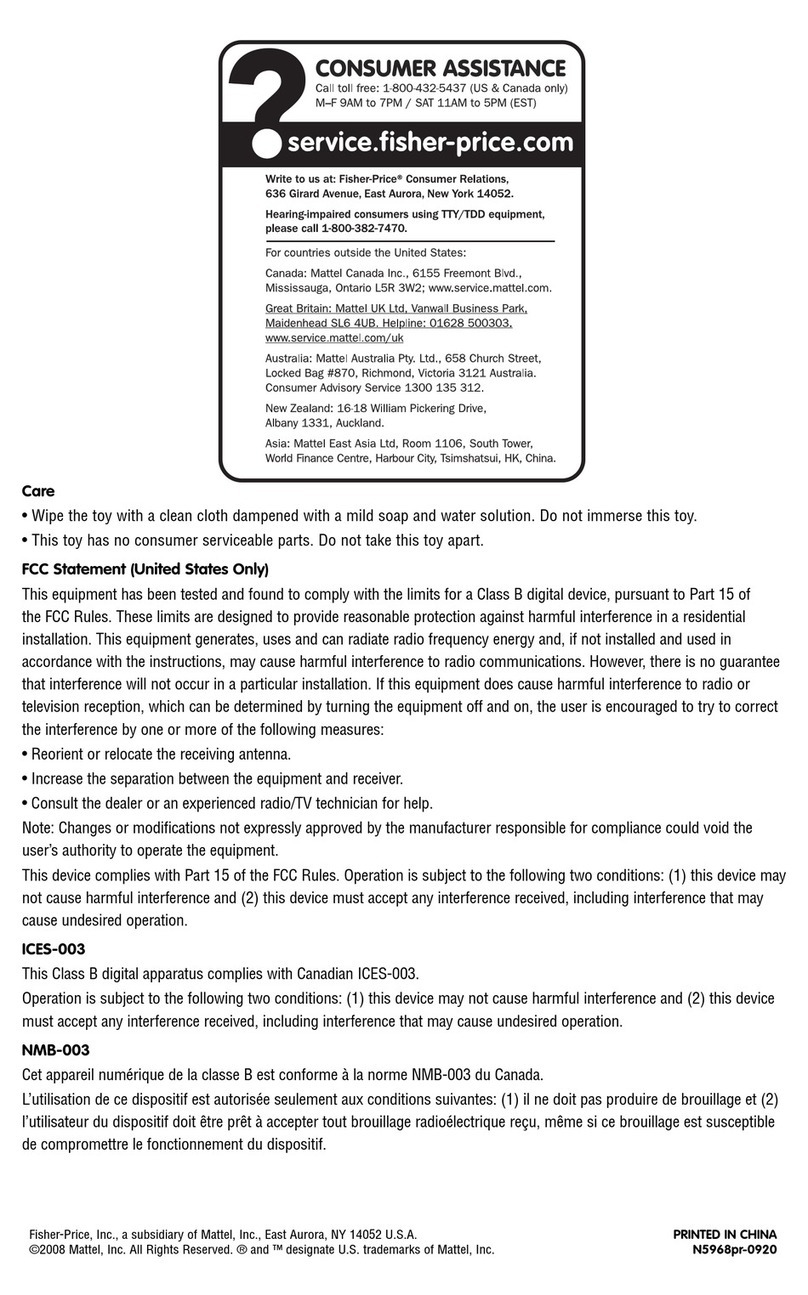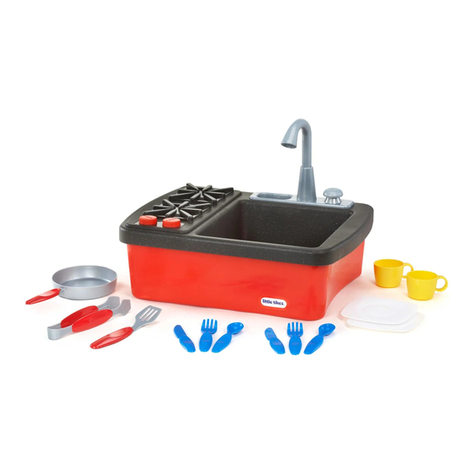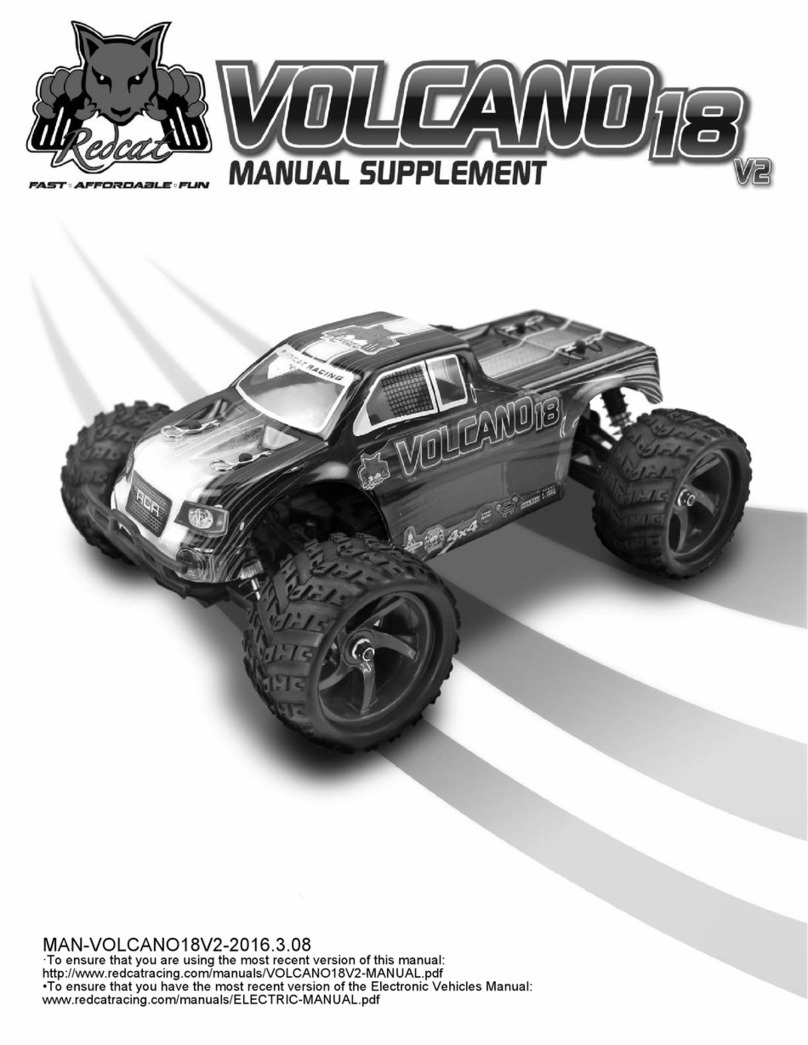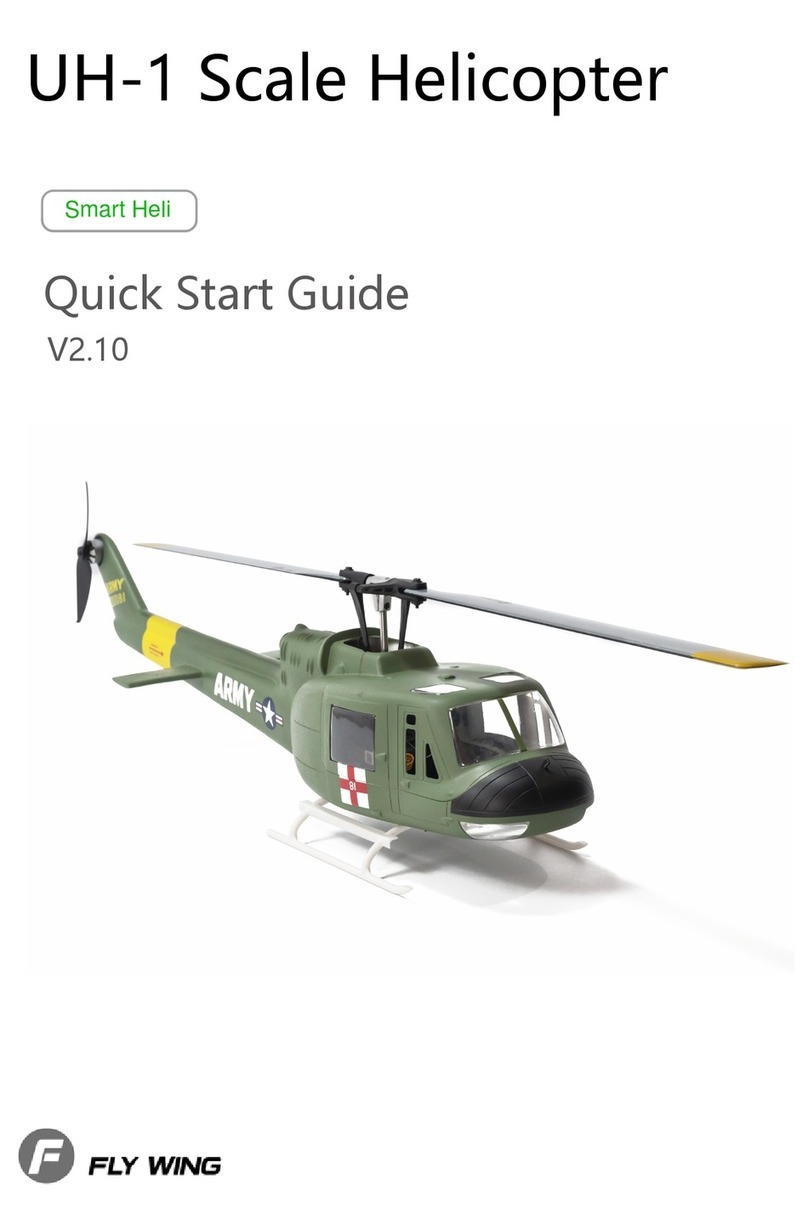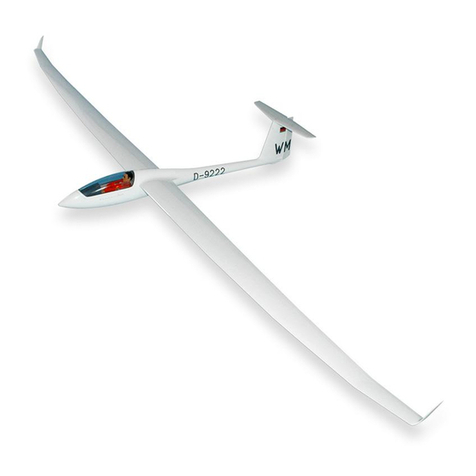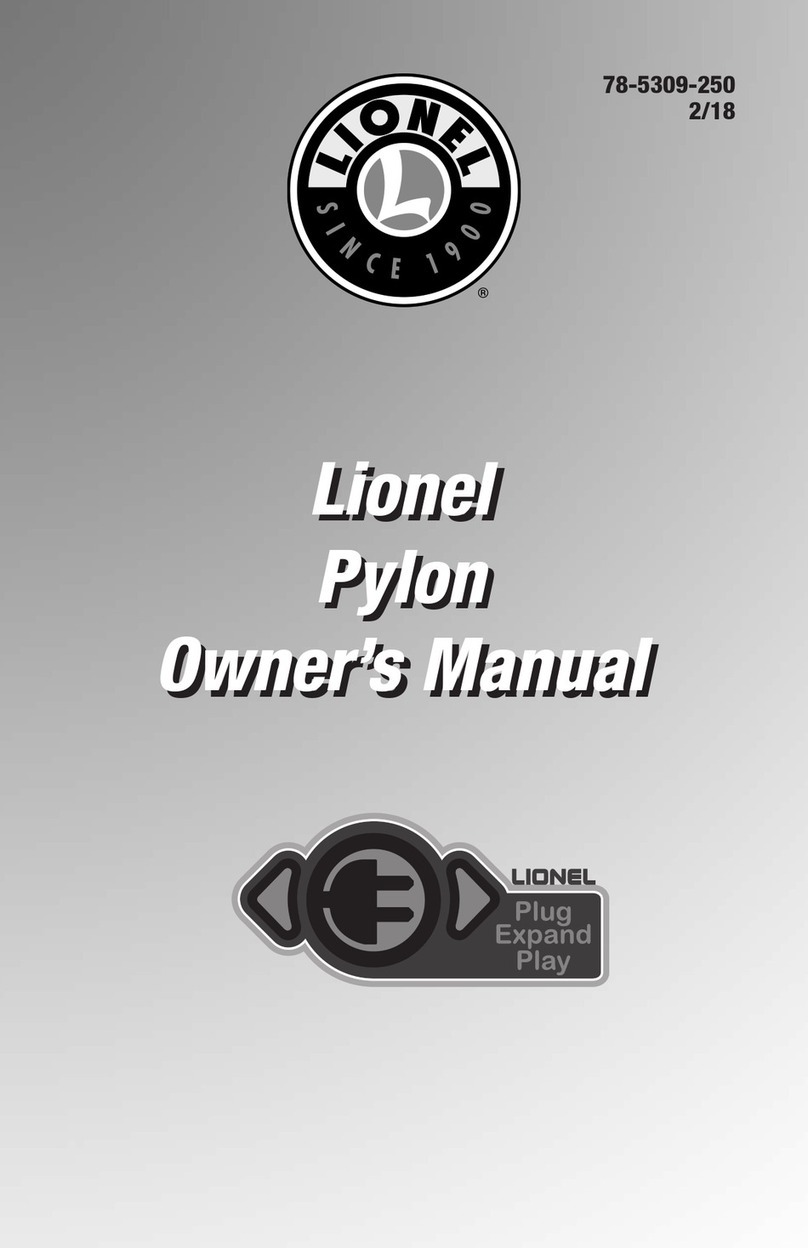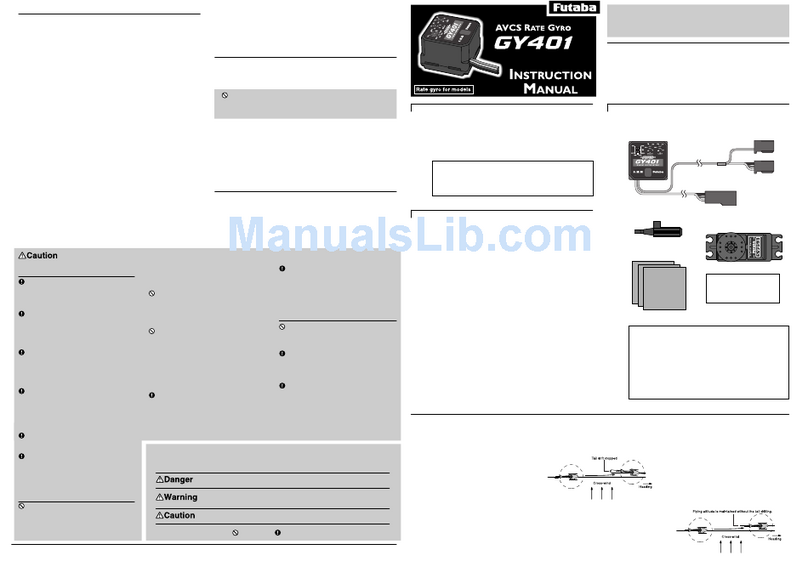Moustache DHC-2 Beaver User manual

20cc DeHavilland Canada
DHC-2 Beaver
Instruction Manual
Version 1.1

©2019 Moustache Model Works, LLC 2
20cc DHC-2 Beaver Instruction Manual
Thank You
Thank you for purchasing the Moustache Model Works 20cc DHC-2 Beaver!
This Beaver was designed using AutoDesk Fusion360, a powerful 3D CAD program, to ensure the best
parts fit possible and therefore provide a pleasurable building experience. Drawn directly from the full-
scale blueprints, it features about a 99% scale outline. Traditional construction techniques were used to
keep the build as simple as possible, while modern laser-cut technology helps to keep everything aligned
during construction.
The design intent was to provide a Beaver with a very scale outline, but to keep assembly and setup sim-
ple, accessible, and reliable for the vast majority of pilots who will fly this as a sport scale model. To this
end, the ailerons, elevator, and rudder use simple CA hinges. The large front hatch provides excellent
access to the cockpit for quick battery swaps (electric power version) or for refueling and switch access
(gas/glow version). The wing struts connect with simple clevises.
Dimensions and Specfications
Required to Complete
Electric Power System
E-flite Power 60, 400Kv (EFLM4060A)
Prop Adapter: Power 46/52/60 (EFLM1934)
60A+ ESC, Castle Creations Talon 90 recommended (CSE010009700)
5000mAh 6S 22.2V 30C LiPo Battery
Connectors w/5mm bullets (suggest XT90 or IC5)
16 x 8E Propeller (suggest APC16080E)
1 inch Spinner Nut 8mm x 1.25mm: P-47D-1 60 (HAN279011)
Gas (Petrol) Power System
DLE-20, DLE-20RA (DLEG0020 or DLEG0420) or equivalent
Sullivan 10 oz. Slant Fuel Tank (SUL440), requires Sullivan Gasoline Conversion Kit (SUL484)
Propeller (suggest APC 16 x 6, APC16060)
Ignition battery and switch, OR Tech-Aero iBEC (http://www.tech-aero.net/ultra-ibec)
Radio Equipment
2 x Standard size servos, 75+ oz-in torque (prototypes used Spektrum A6150)
4-5 Mini servos, 60+ oz-in torque (prototypes used both Hitec HS-5245MG and Spektrum A5060)
6-channel receiver, minimum
6-channel computer transmitter with flap-elev mixing, aileron-rudder mixing, and differential aileron throw
strongly recommended
4 x 18-inch (45cm) servo extensions
1 x Y-harness
2 x 12-inch to 18-inch (30-45cm) servo extensions, depending on length of the Y-harness)
Although mini servos are recommended for the flaps, ailerons, and throttle, standard servos may be used.
Wingspan: 91.4 in (2.32m)
Length: 57.6 in (1.46m)
Height: 16 in (406mm)
Weight: 12 - 13 lb (5 - 5.7 kg)
Wing Area: 904 in2 (58.3 dm2)
Airfoil: NACA 4415
Scale: 1/6.3

©2019 Moustache Model Works, LLC 3
20cc DHC-2 Beaver Instruction Manual
Required to Complete (continued)
Wheels: Standard size is 3 3/4” dia (95-100mm) with 5mm axle hole
Tundra size is 4 1/2” - 5 1/2” dia (115-140mm) with 5mm axle hole
5mm Wheel Collars x 4
Battery strap, hook-and-loop (Velcro), 12”-15” long (30-38cm) (used for either battery or fuel tank)
Hook-and-Loop material for battery mounting
Sponge rubber, 1/4”-1/2” thick (6mm-13mm) for isolating fuel tank
1/8” (3mm) Black heat shrink tubing, 2” long (50mm) for door handles
Adhesives
4-6, 1-oz bottles of medium CA
1, 1-oz bottle of thin CA
1 can CA accelerator
5-15 minute epoxy
30 minute epoxy
Blue thread lock
Epoxy finishing resin (for gas or glow engines only)
Milled fiber (available from BVM, item number PA-SR-1905)
Microballoons (Top Flite TOPR1090 or Deluxe Materials DLMBD15)
Liquid cement for plastic models (TES3507AT)
4 Rolls covering material (6’ or 2m rolls)
Spray Paint (suggest Krylon primer and paint for most applications)
Craft paint for interior of fuselage,
Options
Besides the choice of power system, the Beaver offers two primary ways to customize your model. First,
you may choose either the upper carb intake or the lower carb intake (chin scoop). The chin scoop was
used on the earlier airplanes, but most Beavers we see today use the upper carb intake. Second, we
have provided both round and rectangular windows for the aft fuselage. You may choose to use one
round, one rectangular, or two rectangular windows per side, depending on the aircraft you choose to
model. If you choose a single rear window, the aft window bay is simply covered with the covering materi-
al. If you choose the rectangular window(s), the pre-cut forward window bay will need to separated from
the fuselage side to accommodate.
Building Notes
The 20cc Beaver was designed to minimize the need for plans during construction. The tail surfaces and
fuselage can be built on a flat surface, separate from the plans. The wings are built over the plans simply
to aid in placing the lower cap strips and the sheeting. NOTE: IF THE WOOD PARTS DO NOT MATCH
THE PLANS, BELIEVE THE WOOD! Paper plans can stretch and shrink considerably with humidity and
temperature variations, but wood is much more stable.
Use medium CA for most of the assembly. When gluing lite-ply parts, note that the lite-ply is VERY
THIRSTY, meaning it will suck-up and absorb a large amount of glue, especially on the edges. To ensure
the integrity of your glue joints, apply a coat of glue to the edge, wait about 30 seconds for it to soak in,
then apply more glue. Keep doing this until the medium CA stops soaking into the wood, then press the
parts together to complete the joint. Usually 2-3 coats are sufficient. For best strength, try to minimize
your use of CA accelerator.
The recommended build order is tail surfaces, wings, fuselage. It’s helpful to have the wings done when
you fit the windshield hatch in place, and it helps to have the horizontal tail done when you glue the aft fu-
selage together. There are many small details, however, especially as you’re completing final assembly,
that do not need to be completed in any particular order.

©2019 Moustache Model Works, LLC 4
20cc DHC-2 Beaver Instruction Manual
Building Notes (continued)
You will notice the manual shows several lightening holes in the flaps, ailerons, elevator, rudder, and fuse-
lage top. These were tried in the second prototype, which was used for creating this manual. After com-
pletion, we decided the weight savings was not enough to warrant the potential reduction in scale appear-
ance, so they were removed for production.
Floats are probably the most important option for any DHC-2 Beaver. As of this writing (January 2019),
the floats for this airplane have not been developed, but the float mounts have been incorporated into the
build. These mounts are not accessible after the airplane is built, so make sure you install them during
construction if you have any interest in installing floats once they are available.
Several exterior parts will require painting: the cowl, windshield hatch, optional upper carb intake, oil cool-
er, landing gear fairings, and possibly the tail cone and rudder fairing. If using a gas (petrol) or electric
power system, we have found Krylon brand spray paints to be easy to use and quite durable. If you need
a specific paint match and have spray equipment available, common latex paint from the local big-box
home improvement store works well, is available in sample sizes, and can be matched to any covering
you bring to the store. In this case, it’s good to use a clear coat, again such as Krylon, although we’ve had
mixed results spraying Krylon (which is acrylic) over latex. If you’re using a glow engine, Wings West
makes some fantastic paint that perfectly matches both MonoKote and Ultracote, but it requires clear coat
to be fuel proof.
If using a gasoline engine, the electrical power system can be simplified by using an ignition battery elimi-
nator circuit or iBEC. This simple component enables a single battery to power both the radio system and
the ignition, while also providing a transmitter-switched ignition kill. If HV-capable servos are used, a sin-
gle 2S Li-Po battery can provide all the power required, thus saving weight and complexity.
Due to variations in hardware, it’s possible that the included blind nuts may not fit perfectly into the laser-
cut holes of some wooden parts. If this happens, simply drill out the holes to fit.
Recommended Tools
FLAT building surface, T-pins
Sanding block(s) - next to a flat surface, probably the most important tool in the shop. We use a piece of
1/2” - 3/4” plywood cut to 3” x 11” to accept 1/3 of a sheet of sandpaper. Use a good-quality ceramic abra-
sive and apply 120 grit on one side and 80 grit on the other using contact cement like 3M77.
Hobby knife with No. 11 blades (buy in bulk, part number EXL22611A)
Rotary tool (Dremel) with sanding drum, cutoff wheel
Electric drill and drill bits
Allen wrenches, both SAE and metric
Slotted and Philips screwdriver sets, several sizes
Pliers, regular and needle-nose
Adjustable wrench
Razor plane or buck knife
Steel rule
Wax paper
Fine-point permanent marker
Soldering iron/gun (for soldering connectors if using an electric power system)
4 1/2” Tapered palette knife (recommended for mixing and applying epoxy)
Limit of Liability
Responsibility for safe assembly and operation of this kit depends entirely upon the builder and operator. As Mous-
tache Model Works, LLC has no control over the assembly, setup, modification, use, or misuse of this product, no
liability shall be assumed nor accepted for any resulting damage or injury caused by its use or misuse.

©2019 Moustache Model Works, LLC 5
20cc DHC-2 Beaver Instruction Manual
1. Remove all the horizontal tail parts from
the laser-cut sheets
a. Ribs, Sub-LE from 2.5mm sheet balsa
b. Spar/TE and Spar Doubler from 6mm
sheet balsa
c. HS-8 doublers from 3mm lite ply
2. Glue the Spar Doubler to the Spar/TE.
Center the doubler vertically so there is
equal overhang top & bottom.
3. Glue HS-1A and HS-3 through HS-8 to
the Spar/TE. Use a scrap piece of lite-ply
with a 90° corner to ensure the ribs are
perpendicular to the Spar/TE. Do not glue
HS-2a to the Spar Doubler at this time.
4. Assemble both HS-2as onto the stab, as
well as HS-9 and both Sub LEs
9. Glue the bottom skins in place using
medium CA. Laser-etched lettering
inside!
5. With the Spar/TE on the work bench
and the ribs facing up, look down on the
stab and check for any twist. If the stab
is twisted, hold a corrective twist in
place while gluing each HS-2a to the
Stab Doubler.
6. Glue the remaining glue joints between
the ribs and the Sub LEs, and HS-9
10. Glue in the hinge reinforcement
blocks, as well as the HS-8 Doublers
(3mm lite-ply).
11. Glue the top skins in place using medi-
um CA. Laser-etched lettering inside!
7. Using a sanding block, gently sand a
bevel in the Spar/TE and the Sub LE to
match the airfoil.
8. Remove the H-Stab Skins from the
laser-cut sheets, including the little trian-
gles; glue the little triangles in place on
the leading edges of the H-Stab Skins.
Horizontal Stabilizer and
Elevator
Note that the included hardware is
separated into different bags for
each section of the build.

©2019 Moustache Model Works, LLC 6
20cc DHC-2 Beaver Instruction Manual
13. Cut two 12 1/8” lengths from the 6mm
x 10mm balsa stick
14. Glue in place on the leading edges
15. Carve & sand to airfoil shape
16. Glue the spacers in place against both
HS-2as
20. Glue E-8 and E-7 onto the Stab Tip
Cores
17. Remove all the elevator parts from the
laser-cut sheets
a. Ribs from 2.5mm sheet balsa sheet
10/10
b. LE, joiner supports and hinge sup-
ports from 6mm balsa sheet
c. Stab Tip Cores and the E-8s from
the 1mm ply sheet
21. Remove the Elevator Skins from the
1.5mm sheet balsa
22. Glue the LE/rib assemblies to the bot-
tom Elevator Skins. Make sure the
laser etching on the skins is on the
inside surface. Use the stab tip as-
semblies to aid positioning.
18. Glue the ribs E-1 through E-6 to the
leading edges. Take care to center the
ribs vertically on the LE. As you did on
the horizontal stabilizer, use a scrap
piece of lite-ply with a 90 degree corner
to ensure the ribs are perpendicular to
the LE.
12. Trim & sand the sheeting flush with the
Sub-LE and all around the perimeter.
19. Using a sanding block, lightly sand the
top and bottom of the LE to match the
taper of the ribs
23. Place the elevator on the edge of your
work bench. Using a sanding block,
sand a bevel on the inside surface of
the bottom Elevator Skins to match the
ribs. The trailing edge of the sheeting
needs to be about ½ the thickness of
the sheeting or 1/32” at the trailing
edge.

©2019 Moustache Model Works, LLC 7
20cc DHC-2 Beaver Instruction Manual
26. Glue on the top Elevator Skins.
27. Glue the upper & lower tip blocks, then
carve & sand to shape.
27. Sanding to shape. Use some masking
tape to avoid sanding into the elevator
sheeting while using coarse sandpa-
per at first.
32. Glue the elevator joiner in place using
epoxy on the mounting tab. Take care
not to get glue on the wire.
33. Glue the beavertail in place over the
joiner. Take care not to get glue on the
wire.
28. Glue both HS-2b and HS-1b to the low-
er beavertail skin.
34. On the leading edge of the elevators,
mark and drill the location of the eleva-
tor joiner. To do this, hold the eleva-
tors in place against the horizontal
stabilizer and use a piece of scrap
2.5mm balsa as a spacer between the
tip of the stabilizer and the inside edge
of the elevator counter-balance. Mark
the location, then drill in straight with a
1/8” bit.
29. Cut a relief groove in the trailing edge of
the horizontal stab to provide clearance
for the elevator control horn. Also cut a
bevel in the slot for the joiner mounting
tab so it seats up against the trailing
edge.
24. Glue in the elevator joiner supports
and the hinge supports.
25. Glue in the tip assemblies.
30. Bevel the trailing edge of the lower bea-
vertail skin as you did with the eleva-
tors.
31. Glue the upper beavertail skin in place.
35. Using a hobby knife, cut a notch from
that hole to the inboard end of the
elevator. Cut a radius in that notch to
accommodate the radius in the bend
of the elevator joiner.

©2019 Moustache Model Works, LLC 8
20cc DHC-2 Beaver Instruction Manual
37. Mark a line down the center of the
elevator leading edges. This is easier
with a simple hinge marking tool like
the Great Planes GPMR4005.
38. Mark the hinge locations and cut the
hinge slots using a hobby knife or a
hinge slotting tool.
39. Mark the angle of the leading edge
bevel on the ends of the elevators, and
on the upper and lower elevator skins
if you like.
40. Using those marks as guides, carve
and sand the bevel in the leading edg-
es of the elevators.
41. Cover the stab and elevators with your
favorite iron-on film covering. Leave the
bottom side of the stab center section
uncovered for gluing into place on the
fuselage.
42. Trim away the covering from the eleva-
tors at the elevator joiner.
1. Remove the vertical stabilizer and
dorsal fin parts from the laser cut
sheets
a. VS-1 through VS-7, D-1, -2, and -3
from 2.5mm balsa sheets 9 & 10
b. Trailing edge, hinge supports and
rudder blocks from 6mm balsa
c. Dorsal spine and rudder tip from
1mm ply
43. Hinge the elevators to the stab using
the supplied CA hinges. Glue into the
elevators first, then use epoxy to glue to
the elevator joiner. Be sure to keep the
elevators aligned, and use a wax paper
barrier to prevent gluing the elevator
joiner to the stab. Finally, glue the CA
hinges into the stab.
36. Check the alignment of the elevators
to each other on the elevator joiner.
Adjust the hole you just drilled on one
side only to bring the elevators into
alignment.
2. Glue VS-2 through VS-6 to the trailing
edge using the 90° guide used on the
horizontal stab & elevators. Note the
longer tabs insert into the trailing edge.
Vertical Stabilizer and
Rudder
No Photo

©2019 Moustache Model Works, LLC 9
20cc DHC-2 Beaver Instruction Manual
4. Glue D-3, D-2, and VS-7 to VS-1 also
using the 90° guide.
5. Glue the two assemblies together.
13. Fit the 1mm ply Dorsal Spine in place
and mark the thickness of D-1 along
the edge on both sides.
8. Glue the hinge supports in place.
3. Glue VS-8 to VS-4, -5, and -6
14. Using that mark as a guide, glue the
Dorsal Spine LE 1 pieces (1.5mm
balsa, sheet 1) to the Dorsal Spine on
both sides.
6. Sand off the tip of the VS-8 tab that
protrudes through VS-7
7. Glue D-1 in place.
9. Remove the vertical stab skins from the
1.5mm laser cut sheets.
10. Glue the skin parts together matching
the edges that have the edges labeled
for right and left skins.
11. Lightly block sand the framework
smooth to prepare for installing the
skins (sheeting).
12. Glue on the left and right skins.

©2019 Moustache Model Works, LLC 10
20cc DHC-2 Beaver Instruction Manual
16. Glue the Dorsal Spine in place.
22. Sand leading edge and Dorsal Spine
LE pieces to shape. Refer to the plans
to aid in achieving the right profile.
Any gaps can be filled with filler before
covering.
19. Trim and/or sand off the tab from VS-5
that pokes through VS-8.
23. Remove the rudder parts from the
laser-cut sheets
a. Leading Edge, 2nd Leading Edge
and rudder blocks from 6mm balsa
b. R-1 – R-6 from 2.5mm balsa
c. Tip core and rib from 1mm ply
17. Remove the Dorsal Skins from the
1.5mm laser-cut sheets and assemble
the same way as the vertical stab
skins, matching the edges with text
labels for both left and right skins.
18. Glue the Dorsal Skins in place.
20. Sand the ends of the Vertical Stab lead-
ing edge to fit between the tabs on VS-6
and VS-7. NOTE: the tabs on VS-6
and VS-7 are used to serve as guides
when sanding the leading edge to
shape.
21. Once satisfied with the fit, glue the
leading edge in place.
15. Glue the Dorsal Spine LE 2 pieces in
place. Note that LE 2 extends past the
end of LE 1, flush with the end of the
Dorsal Spine.
No Photo

©2019 Moustache Model Works, LLC 11
20cc DHC-2 Beaver Instruction Manual
25. Assemble R-6 and the plywood rib to
the Rudder Tip Core.
32. Glue in the rudder block pieces, the
rudder torque rod support blocks.
33. As done on the elevators, sand a bev-
el in the trailing edge of the skin to
match the ribs.
34. Glue on the second rudder skin,
matching the other skin at the trailing
edge.
35. Glue on the left and right rudder tip
blocks.
27. Using the vertical stabilizer as a guide,
now glue the tip assembly to the rud-
der leading edges. Be careful not to
glue the rudder to the vertical stabi-
lizer.
28. Lightly block sand the framework
smooth to prepare for installing the
skins (sheeting).
29. Remove the rudder skins from the
1.5mm balsa laser cut sheets.
30. Glue the skin parts together matching
the edges that have the edges labeled
for right and left skins.
31. Note skin alignment to 2nd leading
edge.
31. Glue one side of the rudder skin in
place. Use the tip plywood rib as a
guide; match the trailing edge of the
skin to the trailing edge of the tip core.
Note the leading edge of the skin is
not straight: the leading edge of the
skin at the tip will rest about 1/8” aft of
the edge of the 2nd Leading Edge,
while the lower front corner of the skin
falls about ¼” aft of the same edge.
(see photos in next box)
24. Glue the ribs to the Leading edge
using the 90° guide.
No Photo
26. Glue the 2nd Leading Edge to the
Leading Edge using the tip assembly
as a guide. Be careful not to glue the
tip assembly in at this time.
No Photo

©2019 Moustache Model Works, LLC 12
20cc DHC-2 Beaver Instruction Manual
37. Carve & sand the bevel on the rudder
leading edge.
39. Cover the fin and rudder with your
favorite covering film.
40. Trim the covering away from the rud-
der where the torque rod attaches,
then glue the torque rod into place.
41. Hinge the rudder to the fin using the
supplied CA hinges.
36. Carve and sand the tips to shape.
Note the tip radius transitions to a flat
trailing edge where the tip cores meet
the skins at the trailing edge.
38. Drill a 1/8” hole (3mm) for the rudder
torque rod, 5/16” (8mm) from the bot-
tom of the rudder. Cut a groove from
that hole to the root to allow the torque
rod to nest into the rudder leading
edge. Cut or file a radius between the
hole and the groove to get a better fit.
Wings
1. Lay the plans on the building board and
cover with wax paper.
2. Lay the leading edge sheeting (2.5mm x
3” x 48”) in place over the plan and pin
in place. Do not trim the LE sheeting to
width at this time.
3. Do the same with the trailing edge
sheeting (2.5mm x 3/4” x 48”).
4. Cut a piece 9 3/4” (248mm) long from
the 2.5mm x 4” x 48” sheet for the cen-
ter section sheeting (root end of the
wing), then trim it to 3 3/4” wide
(95mm). Glue and pin in place to the
leading edge and trailing edge sheeting.
5. Use the laser-cut, 6mm thick trailing
edge to determine where to trim the
LE & TE sheeting to length. It should
be close to 39 1/8” in length. Since
paper plans are more subject to distor-
tion over time due to heat and humidity
changes, we prefer using the wood
trailing edge to determine the proper
length. Also, we prefer to trim the
sheeting a little long at this time and
sand flush on both ends after the wing
is removed from the building board.
6. Again using the laser-cut trailing edge,
mark the center location of the cap
strips on the leading edge and trailing
edge sheeting.

©2019 Moustache Model Works, LLC 13
20cc DHC-2 Beaver Instruction Manual
8. Glue the laser-cut 2.5mm balsa flap
and aileron hatch fillers in place.
11. Remove the ribs from the laser cut
sheets, including R-1 from 3mm lite-
ply.
12. Glue the tip of the Wing Sub LE to the
Wing Sub LE. Use a straightedge to
ensure proper alignment.
7. Trim and sand the capstrips to length
from the 2.5mm x 10mm sticks and
glue them in place.
9. Glue the laser-cut 6mm balsa trailing
edge in place on the trailing edge
sheeting. Note the etched label is
meant to be right-side-up and facing
forward. The root end of the TE has a
2° angle to place the root rib at the
proper angle to account for the wing
dihedral.
13. Glue the Wing Mount Doubler in place
onto R-1, on the outboard side of the
rib (doubler will be inside the wing).
14. Glue and press the ¼-20 blind nut into
place on the Wing Mount Doubler. 5-
minute epoxy is good for this. Again,
the nut will be inside the wing once
assembled.
15. Trim the bottom spar to length, a little
longer than needed. As with the
sheeting, excess length will be sanded
flush with the root and tip ribs after
assembly.
16. Using a rib at the root, one at the tip,
and one or two in the middle, glue the
bottom spar to the leading edge sheet-
ing, the cap strips, and the hatch fill-
ers. NOTE that the spar overhangs
the leading edge sheeting by
1/8” (3mm) to provide a better joint for
the cap strips.
17. Before gluing the ribs in place, perform a dry assembly of the ribs, upper spar, Sub LE,
Ply Shear Web, and wing tube sleeve to familiarize yourself with how everything fits to-
gether. Points to note:
a. The 1.5mm Ply Shear Web has a 2° angle on the root end and is the primary tool for
getting the proper angle on the root rib. It also fits rather tightly into place.
b. There is a slight taper to the chord of the wing between R-1 and R-3. When gluing
the Sub LE in place, glue from R-3 outboard first, then come back and glue it to R-2
and R-1, bending it into place.
c. The airfoil is flat from the spar to the trailing edge, but from the spar forward curves
upward to the leading edge.
18. Disassemble the dry assembly.
10. Inspect the spars for bow. Select,
pair, and mark the spars so the bow of
the upper and lower spars counteracts
each other, meaning either the con-
cave or the convex sides face each
other. This step ensures the spars do
not make the wing bow over time.
No Photo

©2019 Moustache Model Works, LLC 14
20cc DHC-2 Beaver Instruction Manual
20. Glue the Ply Shear Web in place
against the aft edge of the bottom
spar.
21. Glue rib R-1 in place, making sure it’s
firmly against the Ply Shear Web to
establish the proper angle.
24. Before gluing the Sub LE in place,
sand a slight bevel into the bottom
edge to match the contour of the ribs.
This bevel will enable the bottom
sheeting to glue properly into place.
Once the bevel is done, glue the Sub
LE in place.
19. Glue all ribs from R-2 outboard into
place from the spar to the trailing
edge. Use the Ply Shear Web as a
tool to keep ribs R-2 – R-5 aligned
properly.
22. Glue the upper spar in place. The
most important joint in this step is
where the spar glues to the Ply Shear
Web, so use sufficient glue to ensure a
solid joint here.
25. Fit the 1.5mm ply flap hatch liner in
place. The narrow edge goes forward
against the spar. Don’t glue in place
until you test the fit the wing tube
sleeve in place. If the wing tube
sleeve won’t slide in over the top of the
hatch liner, then sand a slight relief in
the hatch liner using a sanding drum
on a rotary tool. Glue the flap hatch
liner in place.
26. Glue the aileron hatch liner in place,
narrow edge forward.
27. Glue the shear webs in place (1.5mm
laser-cut balsa). Note the shear webs
at the flap and aileron servo bays are
slightly shorter to allow for the thick-
ness of the hatch liners.
28. Glue the wing tube plug (2.5mm sheet
6) into place inside the wing tube
sleeve (9 5/8” length), flush with the
end. We suggest 5 min epoxy for this
over CA, since cardboard tends to
absorb CA so much.
23. If you have not already done so, trim
the upper spar to length.
29. Glue the wing tube sleeve in place
using 15-30 min epoxy, mixed with
microballoons if you like. The end with
the plug should be outboard. Glue
securely to all ribs and the Ply Shear
Web.

©2019 Moustache Model Works, LLC 15
20cc DHC-2 Beaver Instruction Manual
31. Glue the flap hinge support blocks in
place (6mm laser-cut balsa). See
plans for locations. For the middle
block, you may want to cut a notch out
as for a rabbet joint so the block will fit
over the hatch liner.
35. Use a sanding block to sand the trail-
ing edge and the Sub LE flush with the
upper contour of the ribs so the upper
sheeting will glue properly in place.
30. Glue the 3mm lite-ply flap and aileron
hatch doublers in place. These will
provide more “meat” for the hatch
retaining screws to bite into. Note that
two doublers need to have a bit
trimmed off one corner to make room
for a flap hinge support block. See
plans.
32. Glue the anti-rotation pin support block
in place, followed by the anti-rotation
pin.
33. Glue the aileron hinge support blocks
in place. See plans for locations.
36. Glue the trailing edge upper sheeting
in place (2.5mm x ¾” x 48”). Trim to
length either before or after gluing in
place.
37. Glue the leading edge upper sheeting in place (2.5mm x 3” x 48”). The trailing edge of
the sheeting should be about 1/8” (3mm) forward of the aft edge of the spar to allow a
slight shelf that will ease installation of the upper cap strips. Apply medium or thick CA to
all appropriate spots, then position over the spar first and press into place. Once the CA
on the spar has grabbed, roll the sheeting forward with your hands, starting at the middle
of the wing and working your way toward each tip to ensure the sheeting is adhered to all
the ribs and the Sub LE.
34. Glue the lower leading edge sheeting
to the ribs and the Sub LE. To do this,
slide a thin, strong, and flexible item
like a steel rule under the sheeting.
While holding the wing flat to the table
with one hand, bend the sheeting up-
ward to meet the ribs & Sub LE with
the steel rule. Use medium or thick
CA and glue one rib at a time, working
your way down the wing. You may
want to start in the middle and work
toward each end.
38. Cut another 9 ¾” (248mm) section
from the 2.5mm x 4” x 48” sheet for the
center section upper sheeting (root
end of the wing). Carefully trim & sand
to width to fit into place between the
LE and TE sheeting, then glue into
place.
No Photo

©2019 Moustache Model Works, LLC 16
20cc DHC-2 Beaver Instruction Manual
40. Trim and sand the upper and lower
leading edge sheeting flush with the
Sub LE. Also sand the sheeting flush
with the root and tip ribs at this time.
44. Carve and sand the leading edge to shape as shown on the plans. We find it easiest to
do this in two steps. First, carve & sand the top and bottom of the LE to an angle that’s
tangent to the top and bottom sheeting. Second, sand to the final shape. The Tip Mount-
ing Rib can be used to trace the proper outline onto the ends of the leading edge to help
achieve the proper shape.
39. Trim and sand the upper capstrips to
length and glue them in place.
41. Trim the leading edge (10mm x 25mm
x 48”) to about 39 ½” long.
42. Mark a line on one face of the leading
edge 3 ¾” (95mm) from the end of the
leading edge. Carefully cut about half
to two-thirds of the way through the
leading edge on this line using a razor
saw. This cut will enable the leading
edge to easily bend for the tapered
section between ribs R-1 and R-3.
45. Sand the trailing edge lightly to ensure flatness, to remove any overhang from the upper
or lower sheeting.
46. Fit the Tip Mounting Rib into the fiberglass wing tip. Sand lightly at the leading and trail-
ing edges as required to make the rib fit into the tip. Once satisfied with the fit, glue into
place using epoxy.
43. Glue the leading edge in place against
the Sub LE and the upper and lower
sheeting. The relief cut from the previ-
ous step goes inside against the Sub
LE at rib R-3. Glue the outboard sec-
tion first, then bend the inboard section
into place. Trim and sand the ends
flush with the root and tip ribs.
47. Glue the wingtip in place using medi-
um or thick CA if you’re confident with
your positioning skills, or epoxy if
you’re not.

©2019 Moustache Model Works, LLC 17
20cc DHC-2 Beaver Instruction Manual
49. Cut a length of the ½” (13mm) triangle
stock to 21 5/8” (549mm) and glue in
place on the trailing edge of the wing.
52. Assemble the flap and aileron hatches/servo mounts. The hatches are 1.5mm plywood
and the servo mounts are 3mm lite ply.
a. Two sizes are provided to accommodate either standard-sized or mini servos.
b. Doublers are included to provide more meat for the servo mounting screws. For mini
servos, the doublers fit on the top of the mounts; for standard servos, the doublers fit
on the bottom of the mounts.
c. The angle braces fit on both sizes of mount.
d. The orientation of the hatches is marked on the inside of the hatches.
48. Cut a hole in the trailing edge for the
flap pushrod. This hole needs to be
about ¼” – 5/16” (6-8mm) wide and
about 3/8” (9-10mm) tall, located al-
most to the upper trailing edge sheet-
ing. See plans for spanwise location;
on the left wing the hole is centered
10” (254mm) from the root, and on the
right wing it’s centered 11 ¾” (298mm)
from the root. You may want to wait
until the flaps are finished before com-
pleting this step.
50. Sand the upper surface of the triangle
stock to match the curvature of the
upper surface of the wing. You may
want to use masking tape to protect
the wing while rough sanding.
54. Use the hatches as guides to mark
the locations of the hatch retaining
screws. Drill pilot holes for the screws
using a .050” – 1/16” bit.
51. Drill and file the hole for the flap push-
rod into the triangle stock.
53. Glue the 1mm wing hatch spacers into
place. These spacers ensure the
outer surfaces of the flap and aileron
hatches are flush with the wing sur-
face.
55. Mount the hatches using 2mm x
10mm button head screws.

©2019 Moustache Model Works, LLC 18
20cc DHC-2 Beaver Instruction Manual
1. Remove all the flap parts from the
laser-cut sheets.
a. Skins and ribs from 2.5mm balsa
b. Flap horn from 1.5mm ply
c. Leading edge from 6mm balsa
Note: The flap and aileron skins in these
photos show lightening holes which were
tested in Prototype #2, but were deleted for
production.
6. Glue the leading edge into place.
2. Pin or otherwise secure the lower flap
skin to the building board.
3. Trim a piece of ¼” (6mm) triangle
stock to length and glue into place on
the leading edge.
10. Glue the upper skin in place, keeping
the flap flat on the building board.
4. Glue the ribs into place.
5. Glue the hinge support blocks into
place at the ends of the flap. Wait until
the Flap Horn is installed to install the
third support block.
9. Sand the leading edge and trailing
edge to match the contour of the ribs.
Note that the upper surface of the flap
has a slight contour – the upper sur-
face is not flat.
11. Carve and sand the leading edge to
shape.
Flaps
No Photo
7. Fit and glue the Flap Horn into place.
You will have to deepen the slot in the
leading edge with a file, hobby knife, or
razor saw to get a proper fit.
8. Glue the final hinge support block in
place against the Flap Horn.

©2019 Moustache Model Works, LLC 19
20cc DHC-2 Beaver Instruction Manual
7. Carve the upper surface of the leading
edge, then sand the leading edge and
trailing edge to match the contour of
the ribs. Note that the upper surface of
the aileron also has a slight contour,
just like the flaps.
1. Remove all the aileron parts from the
laser-cut sheets.
a. Skins and ribs from 2.5mm balsa
b. Aileron horn mount from 6mm ply
2. Pin or otherwise secure the lower skin
to the building board.
3. Glue the aileron horn mount in place.
10. Carve and sand the bevel into the
leading edge of the aileron.
4. Cut a piece of the 10 x 19mm balsa to
17 3/8” (441mm) long for the leading
edge.
5. Mark the location of the Aileron Horn
Mount on the leading edge, and cut a
notch in the leading edge so it will fit
over the horn mount.
6. Glue the leading edge in place.
9. Mark a centerline down the leading
edge of the aileron, then mark a bevel
on each end to serve as a guide for
carving and sanding the required bevel
into the leading edge. It can also help
to draw spanwise lines on the top and
bottom of the aileron back from the
leading edge to guide how far back to
carve and sand.
11. Cut the hinge slots in the ailerons
using a tool or a No. 11 blade hobby
knife.
12. Mark the corresponding locations on
the trailing edge of the wing and cut
the hinge slots in the wing.
Ailerons
8. Glue the upper skin to the top of the
aileron.
12. Hinge the flaps to the wing using the
3mm round hinges, but do not glue at
this time.
No Photo
No Photo

©2019 Moustache Model Works, LLC 20
20cc DHC-2 Beaver Instruction Manual
1. Remove the bulkheads from the 3mm
lite ply sheets. Use a hobby knife to
cut through the joining tabs holding the
parts in the sheets. Also remove Bulk-
head 3 from the 6mm ply sheet.
2. Glue the Bulkhead 4 Stiffener in place
on the front side of Bulkhead 4, across
the top.
Fuselage
3. Attach the float mount and strut mount fittings to the aft sides of bulkheads 2, 2.5, 3, and
4 using 4-40 blind nuts and 4-40 x 3/8” Socket Head Cap Screws. Bulkhead labels face
forward, so attach the fittings on the side opposite the etched labels, with the blind nuts
on the same side as the labels. NOTE: ONCE THE FUSELAGE IS BUILT, THE FIT-
TINGS ON BULKHEADS 2, 2.5, AND 3 WILL BE UNACCESSIBLE. Use epoxy on the
blind nuts and threadlock on the cap screws.
4. The blind nuts close to the edge of
bulkheads 2.5 and 3 will probably
overhang the edge of the bulkheads.
Remove the float mounts from these
locations, file the blind nuts flush with
the edge of the bulkheads, and re-
install the float mounts.
5. Glue the 2.5mm balsa sheeting help-
ers to the aft side of Bulkhead 4
(labeled “AFT”) and the forward side of
Bulkhead 2 (labeled “FWD”).
6. If installing a DLE-20 engine (not the -
RA version), trim the forward end of
the floor to the line etched on the top
side, and trim the Motor Box Left Side
to the line etched on it.
7. On the bottom side of the floor (the
side without etching), glue:
a. The servo mount doublers (nested
in the servo cutouts in the floor,
3mm lite ply)
b. The landing gear mount (6mm ply)
c. The servo cover magnet holders
(3mm lite ply, nested in the servo
cover tops)
Table of contents
Popular Toy manuals by other brands
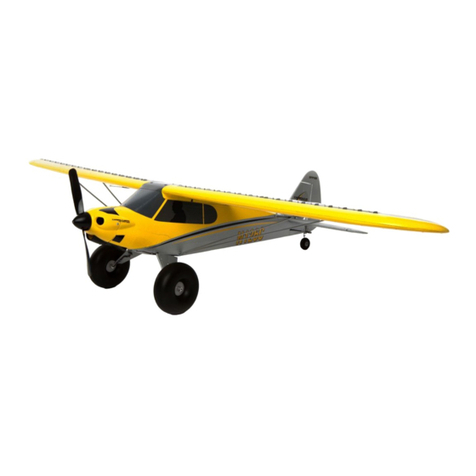
Horizon Hobby
Horizon Hobby hobbyzone Carbon Cub S 2 instruction manual
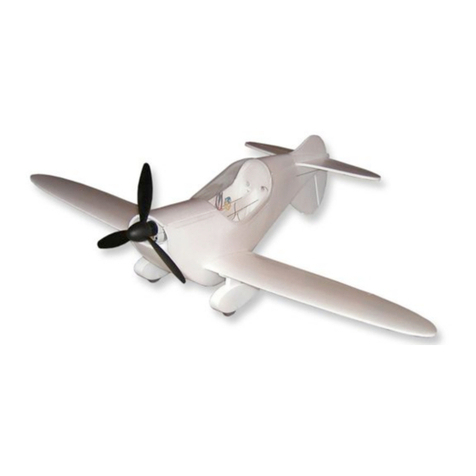
FoamFly
FoamFly Gremlin instruction manual

Little Tikes
Little Tikes Splash Hit Tennis quick guide

Lionel
Lionel Aluminum Passenger Car owner's manual
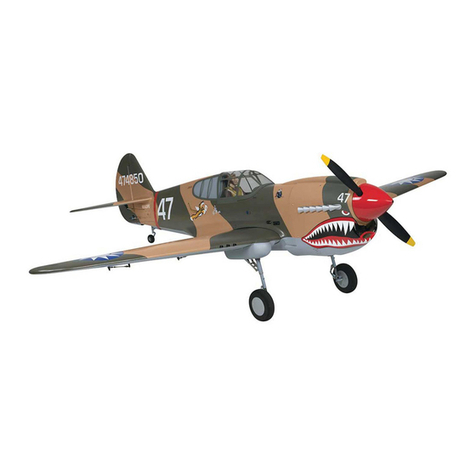
Top Flite
Top Flite P-40 Warhawk Assembly instructions
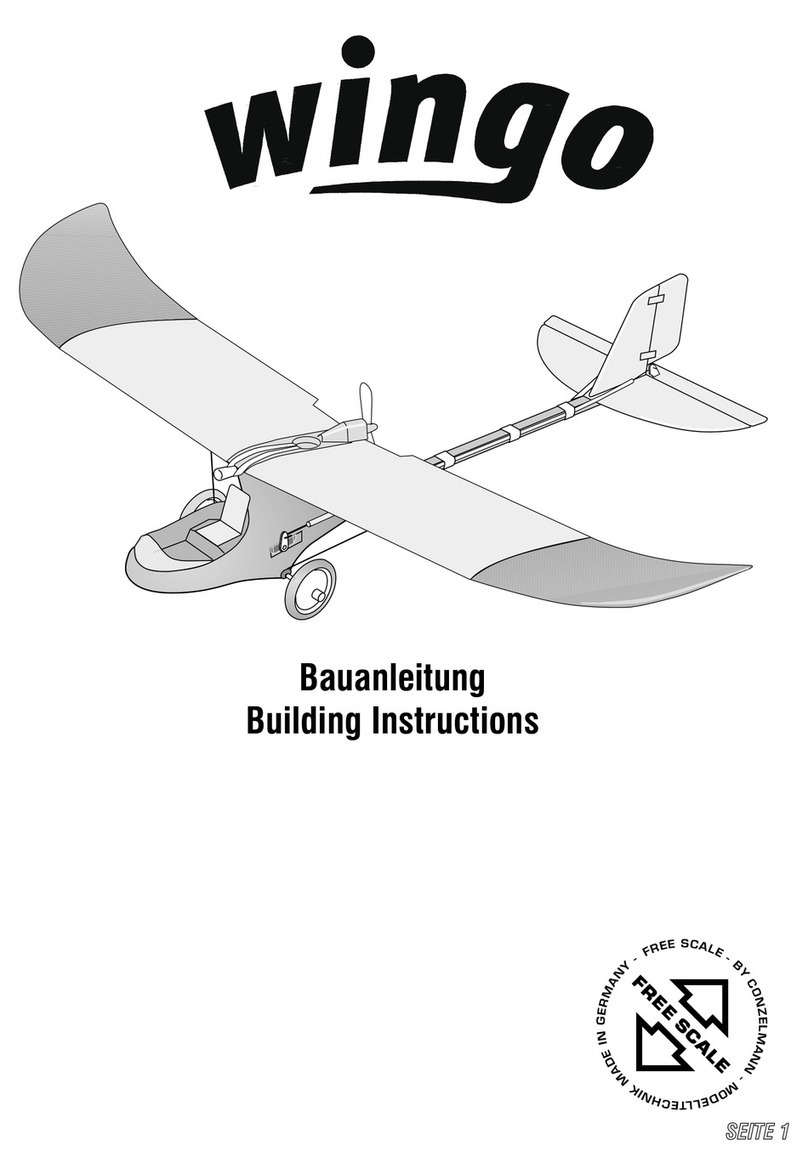
Kavan
Kavan Wingo Building instructions
